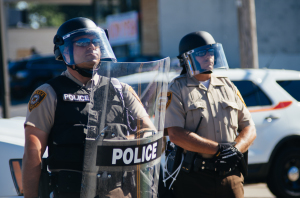False Narratives in Ferguson
BY MAX HANDLER
It has been nearly a week since prosecutor Bob McCulloch announced what that the grand jury had decided not to indict Officer Darren Wilson. Before the words were even out of his mouth (literally, as USA Today had already reported that there would be no indictment) journalists began their work on the think pieces about race in America. People decried the lack of concern for black lives. The protests have even reached the Wash U campus. Yet despite all this grandstanding, it appears that no one bothered to actually check the facts.
The media has driven this entire story. News outlets like CNN have been criticized for the sensationalist manner in which they reported the riots. However, people have been less keen to criticize one thing that is abundantly apparent: these news outlets sensationalized more than just the rioting. They also sensationalized the story itself, twisting and distorting it so that it appeared that Wilson shot Michael Brown because he was black.
The evidence in this case does not support that idea. In fact, the physical evidence almost entirely supports Officer Wilson’s story. The media did not present this evidence, however. Instead, the viewing public only saw eyewitnesses who perpetuated the “Hands Up, Don’t Shoot” version of the story. These witnesses changed their testimony once the autopsy reports were released and generally appeared unreliable. But the media didn’t note this, because it didn’t fit the narrative.
This is in no way  saying that the decision not to indict Officer Wilson was the right one. This is in way saying that blacks in this country don’t face significant racism. This is about the failures of the media and the supporters of Michael Brown. These groups tried to construct a narrative in which Wilson the villain, a racist cop who shot an unarmed black man in cold blood, ignoring all evidence that didn’t fit their narrative. To them, this case had to be about how police treat minorities in America. It had to be about how cops hate black people. They refused to examine the facts, and in doing so must take the blame for their own disappointment. This case was never as clear-cut as they thought it was. It was the never the perfect example of police being racist. But these protestors didn’t care about that.
saying that the decision not to indict Officer Wilson was the right one. This is in way saying that blacks in this country don’t face significant racism. This is about the failures of the media and the supporters of Michael Brown. These groups tried to construct a narrative in which Wilson the villain, a racist cop who shot an unarmed black man in cold blood, ignoring all evidence that didn’t fit their narrative. To them, this case had to be about how police treat minorities in America. It had to be about how cops hate black people. They refused to examine the facts, and in doing so must take the blame for their own disappointment. This case was never as clear-cut as they thought it was. It was the never the perfect example of police being racist. But these protestors didn’t care about that.
As tensions in Ferguson rose, a similar situation erupted in Milwaukee over the shooting of African-American Dontre Hamilton by white officer Christopher Manney. Protesters confronted Police Chief Edward Flynn at a public meeting and later expressed anger over Flynn being on his cell phone during the meeting. In response to questions about the incident from reporters, Flynn went off, and in the process showed exactly why the narrative being pushed in Ferguson is so wrong. Flynn admitted to being on his phone, saying that he was keeping tabs on a five year-old girl who just been shot. Flynn then began to cry as he said, “If some of the people gave a good goddamn about the victimization of people in this community by crime, I’d take some of their invective more seriously. The fact is that the people out here – some of them who have the most to say – are absolutely MIA when it comes to the true threats facing this community. ” Flynn and the men and women he commands risk their lives every day to protect people. And the people they are protecting are, more often than not, black. That is where the “black lives matter” hashtag falls apart. Of course black lives matter, and no one knows that fact better than the people in uniform who risk their lives every day to protect them.
We still have a long way to go in terms of police interaction with minorities. It is obvious that there are serious changes that need to be made. But change will not come if people are unwilling to recognize that everyone has a common goal: protecting the citizens of this country from crime. If we make this about how police hate black people, instead of how police can do a better job protecting them, there will be no progress. Progress will only come if people are willing to work with the police to make things better. Protestors will not be able to achieve the changes that they want if they continue down their current path. As it is, the conversation seems to be focused on whether police hater black people. This conversation is monumentally unhelpful; with the exception of a few anecdotes, all the evidence points to the police caring about minorities. The debate needs to be about the tactics that the police use to try to protect minorities, as some of the policies are arguably racist. However, the distinction must be made that it is the policies, and not the men in uniform, that should be under the microscope. It’s time to move away from this failed narrative and find a better, more productive discussion about Ferguson.